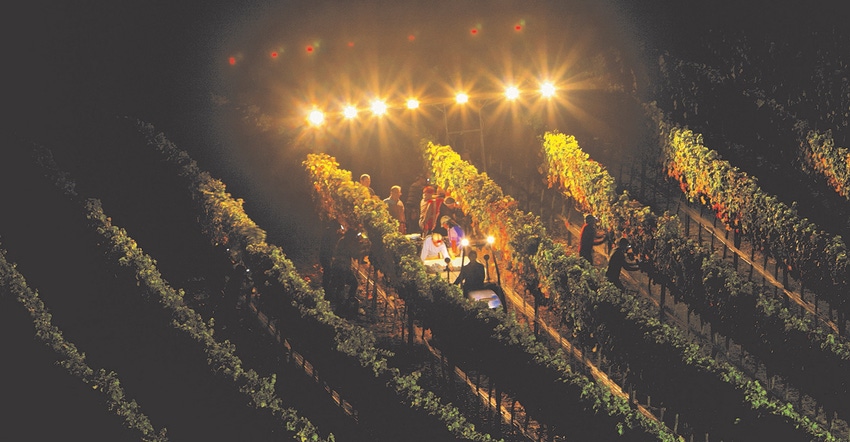
For those who express feelings verbally, it’s been said that, “Wine is Bottled Poetry,” and the poets were at work in full force as August began to roll into September in California’s Napa and Sonoma counties.
For industry members in the Sonoma growing region, action got underway earlier than anticipated in some spots of the Sonoma Valley and Los Carneros viticulture area.
According to the Sonoma Valley Vintners & Growers Alliance, representing nearly 150 grape growers and 100 wineries in the valley, the first rows to be harvested were for the sparkling sector, a Pinot Noir pick.
Karissa Kruse, president of the Sonoma County Winegrowers (1,800 strong), was on hand to ring the official harvest bell on the Sonoma Valley’s 198th harvest.
“This year represented first, fast, and furious,” she said, taking a quick break from harvesting her own 12-acre vineyard on Sonoma Mountain. “Everything started early this season from bud-break to bloom with nothing slowing down in between. I’ve been in this job for a decade now and this is the earliest we’ve started harvest — July 29 — since I’ve been in this role. It’s actually the first time we’ve been ahead of Napa for harvesting sparkling.
“With warm days and cool nights, things became ripe to the point where we were actually doubling up on different varieties that became ripe at the same time and quickly moved us into harvesting, not just sparkling and rose varieties, but still wines earlier than usual. I think things will just keep moving, shifting everything ahead of normal by two to three weeks. While a typical harvest might start in mid-August and go to early November, I think this year will calendar out from late July to being pretty close to completely done by the end of October.”
Despite the early pick, optimism in Sonoma abounds. “All markers are on target,” Kruse says. “Actual yield is coming in a little lighter than some expected because visual checks had indicated a slightly heavier crop. Berries for varieties like Chardonnay and Pinot continue to run a bit smaller, indicating a lighter harvest. Some of our peers in other regions across the state were impacted by frost, but damage here in Sonoma was minimal.”
Return to balance
Summing up anticipation for this year’s harvest: “It should be a good return to balance,” she said. “I think our farmers are happy as they see pricing come back to pre-pandemic levels and they’re signing longer term deals again with the wineries.”
In the Napa Valley, things also got started early — on Aug. 1 (one of their earliest harvests on record) — gathering Sauvignon Blanc, Chardonnay, and Pinot Noir grapes thanks to amenable temperatures both day and night.
The consensus was “somewhat early, somewhat lighter” from older and lower-yielding blocks selected for their higher levels of acidity needed for sparkling production.
Things got so busy in the Napa Valley that industry spokespersons at Napa Valley Grapegrowers and Napa Vintners were unavailable for comment until Jon Ruel at Trefethen Family Vineyards stepped up.
“We have 440 acres spread across two vineyards and grow nine different varieties,” he said. “We’re kind of like Goldilocks in that ‘we’re not too hot, not too cool’ and that’s why we can grow Chardonnay and Pinot Noir in the same vineyard as Cabernet.”
While Ruel says he has previously picked as early as late July, but this year his first day of harvest was Aug. 15. “Every year and every vintage is different as Mother Nature gathers her cards in the winter months, shuffles the deck, and deals different hands every year.
“This is our third consecutive year of drought, so that’s a challenge to manage our water resources. We recycle our winery water and collect rainfall in a settling pond. We’ve gone back to deeper-rooted stock. And still, we expect that when we count up this year’s yield, it’s not going to be a big year, perhaps average or maybe even a bit below average. All conditions accounted for, the quality looks fantastic while the quantity looks to be down from average a little bit. There's been no impact on quality, but a visible impact on quantity. We’ll know more by the time we wrap things up this year, typically by mid-October.”
Despite the hectic activity level of the season, Napa Valley Grapegrowers and the Napa Valley Farmworker Foundation found time to host their 15th annual Harvest STOMP fundraiser in late August.
Designed to provide opportunities for Napa’s vineyard workforce of American and migrant farmers and supported by a large community of grape growers, vineyard managers, winery owners, wine lovers, and vineyard professionals, a record-breaking $3.3 million was raised to help preserve local agriculture and build a legacy for the Napa Valley.
About the Author(s)
You May Also Like




